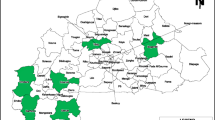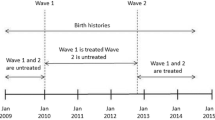Abstract
To report on the design and basic outcomes of three interventions aimed at improving the use and quality of maternity care in rural China: financial interventions, training in clinical skills, and training in health education. Community-based cluster randomized trials were carried out in one central and two western provinces between 2007 and 2009: (1) financial interventions covered part of women’s costs for prenatal and postnatal care, (2) training of midwives in clinical skills was given by local maternity care experts in two- or three-group training courses, (3) health education training for midwives and village doctors were given by local experts in health education in two- or three-group training courses. A survey was conducted in a stratified random sample of women who had been pregnant in the study period. 73% of women (n = 3,673) were interviewed within 1–10 months of giving birth. Outcomes were compared by the different intervention and control groups. Adjusted odds ratios were calculated by logistic regression to adjust for varying maternal characteristics. Most of the differences found between the groups were small and some varied between provinces. The financial intervention did not influence the number of visits, but was associated with increased caesarean sections and a decrease in many ultrasound tests. The clinical intervention influenced some indicators of care content. There was no consistent finding for the health education intervention. Financial and training interventions have the potential to improve maternity care, but better implementation is required. Unintended consequences, including overuse of technology, are possible.
Similar content being viewed by others
References
Borghi, J., Ensor, T., Somanathan, A., Lissner, C., Mills, A., & Lancet Maternal Survival Series steering group. (2006). Mobilising financial resources for maternal health. Lancet, 368, 1457–1465.
Richard, F., Witter, S., & de Brouwere, V. (2010). Innovative approaches to reducing financial barriers to obstetric care in low-income countries. American Journal of Public Health, 100(10), 1845–1852.
Jing, F., & Kaufman, J. (2008). Reproductive health in China: Improve the means to the end. Lancet, 372, 1619–1620.
Wu, Z., Vlisaninen, K., Li, X., & Hemminki, E. (2008). Maternal care in rural China: A case study from Anhui province. BMC Health Services Research, 8, 55.
Feng, X. L., Xu, L., Guo, Y., & Ronsmans, C. (2011). Socioeconomic inequalities in hospital births in China between 1988 and 2008. Bull World Health Organ, 89(6), 432–441.
Wu, Z., Lei, P., Hemminki, E., Xu, L., Tang, S., Li, X., et al. (2012). Changes and equity in use of maternal health care in China: From 1991 to 2003. Maternal and Child Health Journal, 16(2), 501–509.
Wu, Z., Shi, H., Qiao, X., Zhou, Q., Gao, J., Xu, L., et al. (2007). Impact of health VIII support project on maternal care and maternal and child health—Materials and methods. Chinese Primary Health Care, 21(12), 1–2 (Chinese).
Lei, P., Duan, C., Wu, Z., Li, C., Yu, L., Li, X., et al. (2010). Evaluation of Qinba Health Programme: its impact on antenatal care utilization. Chinese Health Resources, 13(2), 64–66. (Chinese).
Liu, X., Yan, H., & Wang, D. L. (2011). The evaluation of “Safe Motherhood” program on maternal care utilization in rural western China: A difference in difference approach. BMC Public Health, 10, 566.
Long, Q., Zhang, T. H., Hemminki, E., Tang, X. J., Huang, K., Xiao, S. B., et al. (2010). Utilisation, contents and costs of prenatal care under a rural health insurance (New Co-operative Medical System) in rural China: Lessons from implementation. BMC Health Services Research, 10, 301.
Zhang, W. H., Raven, J., Zhang, T. H., Shen, Y., Huang, K., Long, Q., et al. (2010). Implementation of interventions in the CHIMACA project. THL discussion paper 13, THL, University print, Helsinki, Finland.
Klemetti, R., Regushevskaya, E., Zhang, W. H., Raven, J., Long, Q., Huang, K., et al. (2010). New mothers’ survey in 2008 in rural China: A CHIMACA report. THL report 23, THL, University print, Helsinki, Finland.
Ministry of Health. (1989). Recommendation for systematic rural maternal care management. Available from: http://www.law-lib.com/law/law_view.asp?id=5532. Chinese. Accessed on 8 September 2011.
Tao, F. B., Huang, K., Long, X., Tolhurst, R., & Raven, J. (2011). Perceptions of postnatal care provision and quality in two rural counties in Anhui province China: A case study. Midwifery, 27(5), 707–715.
Gao, Y., Wu, Z., Shi, H., Gao, J., Xu, L., Liu, Y., et al. (2007). Effects of health VIII project on maternal health services utilization. Chinese Primary Health Care, 21(12), 8–10. (Chinese).
Li, C., Wu, Z., Shi, H., Gao, J., Xu, L., Liu, Y., et al. (2007). The impact of Health VIII Project on the quality of the maternal care services. Chinese Primary Health Care, 21(12), 11–13. (Chinese).
Wu, Z., Viisainen, K., Wang, Y., & Hemminki, E. (2011). Evaluation of a community-based randomized controlled prenatal care trial in rural China. BMC Health Services Research, 11, 9.
Acknowledgments
This work is part of the output of the CHIMACA project (015396), which is funded by the European Commission INCO Programme and is co-ordinated by the National Institute for Health and Welfare, Helsinki, Finland. We thank the local health authorities for their help in carrying out the interventions and organizing the interviews: in Anhui province, Li Guoping, Wang Zhi, Wang Haibao, Lu Xiufu, Yan Hongqiao, Fang Tie, Chen Suping; in Chongqing, Huang Junxia, Long Min, Ou Zhong; in Shaanxi, Wang Zhongyi, Gao Changliang, Liu Hualin, He Xiaoyan, Li Ping, Wei Lanhuai, Zhu Juan, Xiang Qing, Liu Jianping, Zhang Shuhe, Xu Genghui, Lu Bofeng, Li Li. We also thank the township managers, midwives, village doctors, family planning workers and women participating in the intervention and surveys. We thank the local experts for clinical skills training and health education training. We thank interviewers for data collection: in Anhui province, Long Xiang, Xiao Yannan, Liu Liu, Wu Xiaoyan, Zhao Yuanyuan, Liu Feng, Xiao Limin, Cheng Daijuan, Jiang Xiaomin, Xing Xiuya, Xing Chao, Huang Zhaohui, Zhang Anhui, Wang Hong, Zhang Jingli, Chu Zhou, Huang Lei, Zhang Yan, Cao Hui, Sun Lu, Gong Xiangjun, Xu Rong, Liu Fang; in Chongqing, Liu Xiaoxue, Ding Yinting, Song Hong, Liu Tie, Chen Qing, Zhang Zhuan; in Shaanxi, Zeng Lingxia, Zhao Yaling, Tang Aiping, Xing Yuan, Dong Lifang, Liu Xiaoning, Li Chao, Yang Yang, Li Jiangping, Wang Zhenjie, Hu Meiqin, Zheng Xueli, Li Qinli, Zhou Qin.
Conflict of interest
The authors declare that they have no conflict of interest.
Author information
Authors and Affiliations
Corresponding author
Additional information
This study is conducted for the CHIMACA project. The members are Bogg Lennart, Claeys Patricia, Duan Chenggang, Diwan Vinod, Gao Jun, Gao Yan, Hemminki Elina, Huang Kun, Johansson Eva, Klemetti Reija, Li Xiaofei, Long Qian, Raven Joanna, Regushevskaya Elena, Roger Isabelle, Shen Yuan, Tang Shenglan, Tang Xiaojun, Tao Fangbiao, Temmerman Marleen, Tolhurst Rachel, Wang Hong, Wang Yang, Wuillaume Francoise, Wu Zhuochun, Xiao Shengbin, Xie Zheng, Xu Ling, Yan Hong, Zhang Tuohong, Zhang Wei-Hong (in alphabetical order).
Rights and permissions
About this article
Cite this article
Hemminki, E., Long, Q., Zhang, WH. et al. Impact of Financial and Educational Interventions on Maternity Care: Results of Cluster Randomized Trials in Rural China, CHIMACA. Matern Child Health J 17, 208–221 (2013). https://doi.org/10.1007/s10995-012-0962-6
Published:
Issue Date:
DOI: https://doi.org/10.1007/s10995-012-0962-6





